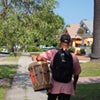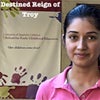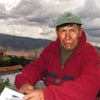Reel Life
A year of hard work came to an exciting culmination Friday, Sept. 9, as nine students in the Master of Arts in Visual Anthropology (MVA) program in USC Dornsife debuted the ethnographic documentary films they spent the past 12 months producing. A reception and screening was held to share their works with family and friends in the Ronald Tutor Campus Center’s Rosen Family Screening Room.
The 20- to 30-minute films they created from conception to post-production covered a spectrum of topics, including the evolving concept of family duty in China; the experiences of professional horsepackers in the Pacific Northwest; the culture of Trojan football at USC; and the challenges transgender people face using public restrooms.
Emma Roll, who studied ethnography and photography as an undergraduate at University of California, Santa Cruz, lived and traveled in El Salvador, Mexico, Nicaragua, Costa Rica, and Panama, where she worked as a surf instructor for five years.
Her film “They Come in Waves” focuses on the effects surf tourism has had in Latin America, which along with an economic boost, can bring disruption to local culture and daily life. The MVA program provided her with a framework within which to document the impact of the phenomenon on film.
“We learned to hone the art of relating to our subjects, the importance of getting to know where they are coming from and how to be patient observers as well as participants in these communities,” she said.
“Through ethnographic research and participant observation, we were able to become a part of whichever community, place, or group we studied, rather than just a film crew that comes into a location for a few weeks and leaves.”
Beginning in Fall 2010, the 2010–11 cohort began an intensive process learning the methodology and theory of creating an ethnographic documentary.
In addition to taking courses in anthropological and ethnographic principles — all students come in with a background in anthropology or social sciences — they receive hands-on training in production techniques, which many of the students are learning for the first time. Labs are taught in the digital media lab at the USC School for Cinematic Arts’ Institute for Multimedia Literacy.
“We did what many students in film school do: learn to use audio and video equipment, write synopses, create budgets, do interviews, make mistakes, log footage, fix mistakes, and edit, edit, edit,” Roll said.
Nicole Hernandez, who majored in visual anthropology in USC Dornsife as an undergraduate, is earning her MVA through USC Dornsife’s progressive degree program. Her film “Destined Reign of Troy” examines the relationship between USC and the neighborhood surrounding it through the perspective of an undergraduate who grew up in a nearby community.
Hernandez said the close-knit group of peers in the program was an invaluable part of her evolution as a filmmaker. “My personal development was pushed to new heights with the help of an amazing cohort of students who gave honest feedback and support all year long.”
Hernandez plans to submit her film to several film festivals now that her project is complete.
Jennifer Cool, a postdoctoral teaching fellow in anthropology who teaches MVA courses, said that the program is specially configured so that students walk away with a broadcast quality work that they can submit to festivals, use to pursue distribution or use as a starting point for a longer feature on their subject.
“There certainly is a market and appetite for this really strong work,” Cool said.
A Friday seminar series within the Center for Visual Anthropology features past graduates and visiting filmmakers, putting students in touch with their colleagues in the ethnographic documentary industry. The center also offers a network of graduates and affiliated faculty that extends back 25 years.
With their program complete, the graduates of the 2010–11 MVA program are now ready to move into the next stages of their ethnographic filmmaking careers.
Roll said she would like to continue her research of surf tourism in other destinations around the world.
“Ultimately I’d like to create a longer version of this film to submit to film festivals to educate the public about these issues, inspire others, and gain followers who could help support a future for ethnographic films in general,” she said.
Learn more about the Master of Arts in Visual Anthropology in USC Dornsife.
Films screened at the event:
 |
“I’m a Trojan” by Dalton Gaudin Gauldin provides an inside look at the culture of college football at USC. |
 |
“They Come in Waves: Surf Tourism in Latin America” by Emma Roll Roll explores how surf tourism is presently playing a role in development throughout Central America particularly what travelers hope to get out of their journeys, how locals are reacting to the changes created by tourism and the potential future of these exotic locales. |
 |
“Clearing Boundaries” by Alyssa Lucca Lucca takes a look at grassroots efforts to promote the importance of cultural preservation within the Garifuna community of Los Angeles. |
 |
“One Child for All: Family Duty in Post-‘80s China” by Sara Kirby Kirby explores whether the concept of family duty is dying out in China with the post-‘80s generation, which older generations worry will refuse to care for the ever-growing population of elderly. |
 |
“It Gets Messy in Here” by Kai M. Green Green challenges gender assumptions and gender identities by delving into the bathroom experiences of masculine-identified queer women and transgendered men of color. |
 |
“The Limbo Period for Quarter-lifers/Emerging Adults/Boomerang Kids” by Parisa Rezvani Rezvani examines the institution of life development in the contemporary United States, focusing on the liminal state from college graduation to “adulthood.” |
 |
“Where the Trail Meets the Sky” by Jim Monahan Monahan explores the lives and labor of professional horsepackers in the Pacific Northwest. |
 |
“Destined Reign of Troy” by Nicole Hernandez Hernandez looks at the relationship between the University of Southern California and the neighborhood surrounding it through the eyes of a USC undergraduate who grew up nearby. |
 |
“Stone and People” by Maren Elwood Elwood captures the challenges that face the descendants of the Inca who live in an active archaeological site in Peru called Saqsaywaman. The film looks at the conflict that ensued as a result of the park management’s mandate to save Inca relics and infrastructures and their desire to modernize the community who live near the monuments. |